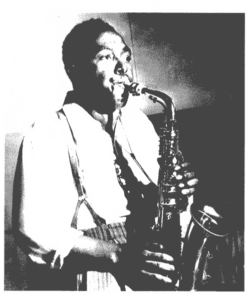Sound And Its Column
The musician’s inner vibration is the raw material of his very expression, which then comes out through his instrument.
Like Standing For The Ovation
The inner vibration of the windplayer expands in his air column, then gets amplified by his instrument, through his vocal cords and his embouchure.
« You should always internalize yourself, this way, stretching the sound out is appropriate, but doing so, just focus on the sound only, and keep your vertical standing up, together with your body opening. »
« When you sing, your body does open up, and it should always behave this way, we name it “sitting on the air“.»
Robert Pichaureau, À tous vents… (Translated by Guy Robert)
« The idea is that the movements of the vocal cords be utilized for the artistic purposes of shaping a sound. »
David Liebman, Developing a Personal Saxophone Sound
from the air column to the sound column
You can live through this slender inner space – rather named “column of sound“ by Alfred Tomatis in The Ear And The Voice – by relaxing your abdomen muscles, focussing on your natural exhaling process : that makes you forget about your embouchure while enhancing your verticality and the deep rooting of the air column, like a tree trunk which would be embodied by your lower limbs.
When focusing on relaxation flowing down your rear back, starting from the end of your natural (and non-forced) inhaling, your air column – or better, your sound column – must be felt as deep as possible, in order to reach its stable position, while you want to prononce « ah » as low as you can : then, you feel as if you were sitting on the radiating vibration, which then excites another column, a physical one this time, your cervical/vertebral spine.
«In correct emission, the larynx is lined up against the cervical spine which, excited by the vibrations transmitted to the larynx by the vocal cords, starts to sing of its own accord.
Under these circumstances, the larynx is excited exactly as the strings of a violin. It is the strings that vibrate and the violin that sings. When the posture of the singer is well aligned, his larynx excites the vertebral column just as if it were that little piece of wood inside the violin that is called the “soul“ of the violin. Its purpose is to carry sound from the anterior plate to the posterior plate. We want to make a column of sound, resonant over and under the glottis, not a column of air, as myth would have it. »
« (…) But it is one thing to talk about a column of air with all the ideas that are usually associated to it : the push, the pressure, tension on the cords, etc.., but a column of sound is something altogether different.
The latter implies relaxation, a measured and tranquil expenditure, being on the lookout for tension, to reduce effort, to avoid pressure.»
Alfred Tomatis, The Ear And The Voice
strings, body and soul
The same process operates with a violin player, who plays his instrument ideally merged with his body : Dominique Hoppenot outlines this resonance-amplification sequence in Le violon intérieur.
Once installed, the air column is ready to “play“ the violinist’s body, as soon as the bow vibrates the string : this vibration gets enriched by the resonance of the violinist’s body, thanks to its transmission through the clavicle, then is amplified by the violin body.
« Thanks to its internal architecture, your body will cease to be an obstacle, behaving then as a true sounding board and as an amplifier of your faithful musical emotions, in the same way as for singers. »
« Such as your voice, your sound is the absolute musical support, the wire that carries the music and inspires emotion. Hence, it is as compelling to “position“ your sound as it is to position your voice. »
« To vibrate, it is necessary (…) at first to start from the idea of sound, not from the obsession of gesture. You should not vibrate to produce a “vibrato“ but to vibrate the sound through a deeply “felt“ pulsation. The good vibrato, able to convey your emotion, therefore picks up your natural vibration and amplifies it at your will.»
« The singers and wind players know for sure that they cannot get a decent sound emission without their breathing being positioned, without their famous “air column“.
They also know that they can neither phrase music, nor actually play it without knowing how to play their breathing with ease.»
Dominique Hoppenot, Le violon intérieur (Translated by Guy Robert)
